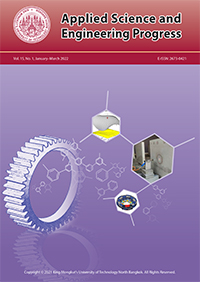Effect of Tool Rotational Speed and Traverse Speed on Friction Stir Welding of 3D-Printed Polylactic Acid Material
Main Article Content
Abstract
Joining of polymers are usually carried out using adhesives that has a deteriorating quality at elevated working conditions thus limiting its application areas. Friction stir welding (FSW) is a growing solid-state welding technology, with applications including the welding of lightweight materials. FSW was recently introduced for joining thermoplastics materials and found successful. This study attempts in employing FSW to join polylactic acid (PLA)-based 3D printed engineering components and assess the effect of FSW process parameters (tool rotational speed and traverse speed) on the weld property. The present work uses the FSW process to butt weld 5 mm thick 3D printed PLA sheets with taper cylindrical profiled tool. For the experimentation, three different combinations of feed rates and pin rotational speeds are considered. Based on joint efficiency evaluation, it is found that tool rotational speed of 1400 rpm combined with 10 mm/min transverse speed produces the weld with high joint efficiency of 40%.
Article Details
References
[2] D. Mishra, S. K. Sahu, R. P. Mahto, S. K. Pal, and K. Pal, “Friction stir welding for joining of polymers,” in Strengthening and Joining by Plastic Deformation. New York: Springer, 2019, pp. 123–162.
[3] R. Nandan, T. DebRoy, and H. Bhadeshia, “Recent advances in friction-stir welding–process, weldment structure and properties,” Progress in Materials Science, vol. 53, pp. 980–1023, 2008.
[4] G. Çam and S. Mistikoglu, “Recent developments in friction stir welding of Al-alloys,” Journal of Materials Engineering and Performance, vol. 23, pp. 1936–1953, 2014.
[5] S. K. Sahu, D. Mishra, R. P. Mahto, V. M. Sharma, S. K. Pal, K. Pal, S. Banerjee, and P. Dash, “Friction stir welding of polypropylene sheet,” Engineering Science and Technology, an International Journal, vol. 21, pp. 245–254, 2018.
[6] A. K. R. Sharma, M. R. Choudhury, and K. Debnath, “Experimental investigation of friction stir welding of PLA,” Welding in the World, vol. 64, pp. 1011–1021, 2020.
[7] S. Katayama and Y. Kawahito, “Laser direct joining of metal and plastic,” Scripta Materialia, vol. 59, pp. 1247–1250, 2008.
[8] S. A. Bakar, S. Sharif, and M. Faridh, “Assessment of friction stir welding on aluminium 3D printing materials,” International Journal of Recent Technology and Engineering, vol. 4, pp. 10975– 10980, 2019.
[9] S. Singh, C. Prakash, and M. K. Gupta, “On frictionstir welding of 3D printed thermoplastics,” in Materials Forming, Machining and Post Processing. New York: Springer, 2020, pp. 75–91.
[10] B. V. Ramnath, C. Elanchezhian, S. Rajesh, S. J. Prakash, B. M. Kumaar, and K. Rajeshkannan, “Design and development of milling fixture for friction stir welding,” Materials Today: Proceedings, vol. 5, pp. 1832–1838, 2018.
[11] A. Arici and Ş. Mert, “Friction stir spot welding of polypropylene,” Journal of Reinforced Plastics and Composites, vol. 27, pp. 2001–2004, 2008.
[12] J. Singh, S. Singh, and V. Dhawan, “Mechanical and biodegradation behaviour of jute/polylactic acid green composites,” Asian Journal of Engineering and Applied Technology, vol. 7, pp. 52–57, 2018.
[13] Z. Du, M. Tan, H. Chen, G. Bi, and C. Chua, “Joining of 3D-printed AlSi10Mg by friction stir welding,” Welding in the World, vol. 62, pp. 675–682, 2018.
[14] V. K. Tiwary, P. Arunkumar, and V. R. Malik, “An overview on joining/welding as post-processing technique to circumvent the build volume limitation of an FDM-3D printer,” Rapid Prototyping Journal, vol. 27, no. 4, pp. 808–821, 2021.
[15] M. P. Alam and A. N. Sinha, “Effect of heat-assisting backing plate in friction stir welding of high strength Al-Li alloy,” Energy Sources, Part A: Recovery, Utilization, and Environmental Effects, pp. 1–12, 2019, doi: 10.1080/15567036.2019.1651793.
[16] Y. Yan, Y. Shen, W. Zhang, and W. Guan, “Effects of friction stir spot welding parameters on morphology and mechanical property of modified cast nylon 6 joints produced by double-pin tool,” The International Journal of Advanced Manufacturing Technology, vol. 92, pp. 2511– 2523, 2017.
[17] E. A. Squeo, G. Bruno, A. Guglielmotti, and F. Quadrini, “Friction stir welding of polyethylene sheets,” The Annals of “Dunarea de Jos” University of Galati, Fascicle V, Technologies in Machine Building, vol. 27, pp. 241–246, 2009.
[18] M. Leite, J. Fernandes, A. M. Deus, L. Reis, and M. F. Vaz, “Study of the influence of 3D printing parameters on the mechanical properties of PLA,” in 3rd International Conference on Progress in Additive Manufacturing (Pro-AM 2018), 2018, pp. 547–552.
[19] A. Arici and S. Selale, “Effects of tool tilt angle on tensile strength and fracture locations of friction stir welding of polyethylene,” Science and Technology of Welding and Joining, vol. 12, pp. 536–539, 2007.
[20] M. R. Ayatollahi, A. Nabavi-Kivi, B. Bahrami, M. Yazid Yahya, and M. R. Khosravani, “The influence of in-plane raster angle on tensile and fracture strengths of 3D-printed PLA specimens,” Engineering Fracture Mechanics, vol. 237, p. 107225, 2020.
[21] A. Arici and T. Sinmazçelýk, “Effects of double passes of the tool on friction stir welding of polyethylene,” Journal of Materials Science, vol. 40, pp. 3313–3316, 2005.
[22] M. Barmouz, P. Shahi, and P. Asadi, “Friction stir welding/processing of polymeric materials,” in Advances in Friction Stir Welding and Processing. Cambridge, UK: Woodhead publishing, 2014, pp. 601–670.
[23] S. Hoseinlaghab, S. S. Mirjavadi, N. Sadeghian, I. Jalili, M. Azarbarmas, and M. K. Besharati Givi, “Influences of welding parameters on the quality and creep properties of friction stir welded polyethylene plates,” Materials & Design, vol. 67, pp. 369–378, 2015.
[24] B. T. Gibson, D. Lammlein, T. Prater, W. Longhurst, C. Cox, M. Ballun, K. J. Dharmaraj, G. E. Cook, and A. M. Strauss, “Friction stir welding: Process, automation, and control,” Journal of Manufacturing Processes, vol. 16, pp. 56–73, 2014.
[25] S. M. Senthil, R. Parameshwaran, S. R. Nathan, M. B. Kumar, and K. Deepandurai, “A multi-objective optimization of the friction stir welding process using RSM-based-desirability function approach for joining aluminum alloy 6063–T6 pipes,” Structural and Multidisciplinary Optimization, vol. 62, pp. 1117–1133, 2021.


